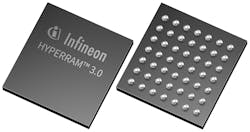V2X Vision: Collaboration Focuses on Low-Cost, Next-Gen Solutions
Vehicle-to-everything (V2X) technology enables vehicles to communicate with one another and their environment, leading to improved road safety. On that front, Infineon Technologies and Autotalks are teaming up to deliver solutions for V2X communication applications, with Infineon supplying its automotive-grade HYPERRAM 3.0 memory for Autotalks' TEKTON3 and SECTON3 V2X reference designs.
“Infineon’s HYPERRAM and NOR flash memories are ideal pairings for our latest generation of V2X SoCs,” said Amos Freund, Vice President R&D of Autotalks.
TEKTON3 is a V2X system-on-chip (SoC) specifically designed for driving actions via connectivity. Concurrent dual-radio and full V2X software implementations typically require external memory to manage modem and application requirements. HYPERRAM is said to meet the cost, density, and performance requirements for these external memories.
TEKTON3 embeds Day1 and Day2 radios operating concurrently. Day1 radio supports either LTE-V2X (C-V2X Rel. 14/15) or DSRC (dedicated short-range communications). Day2 radio supports either 5G-V2X (C-V2X Rel. 16/17/18) or DSRC+ (IEEE802.11bd). Both radios use two antennas with full transmit and receive diversity.
Day2’s main use case is cooperative perception, which means that a vehicle can “see” what the other vehicle is “seeing.” When two vehicles share information they receive, they have better road awareness.
A First in V2X Safety
Another noticeable benefit: TEKTON3-based systems can achieve ISO 26262 ASIL B functional-safety certification, making it the first V2X that can support automatic braking. Autotalks claims that TEKTON3 provides reliability with automotive qualification at 105°C ambient temperature. By integrating V2X software, TEKTON3 enables reduced development and certification efforts and faster time-to-market.
TEKTON3 also embeds all required V2X security functions with a low-latency V2X Hardware Security Module (eHSM) and hardware verification.
SECTON is an automotive-qualified chipset that integrates enhanced-range IEEE802.11p DSRC and C-V2X direct communications (PC5) Rel. 14/Rel. 15 modems, a low-latency eHSM, and hardware-verification engines. In addition, it supports IEEE 802.11a/b/g/n/ac to enable high-bandwidth external vehicle Wi-Fi for supplementary services such as data synchronization with home and high-speed downloads. SECTON has worldwide compliance, supporting U.S., EU, and Japan standards.
In May, Qualcomm Inc. announced that its subsidiary, Qualcomm Technologies Inc., entered into a definitive agreement to acquire Autotalks. Through the acquisition, Autotalks’ standalone safety solutions will be incorporated into Qualcomm Technologies’ Snapdragon Digital Chassis product portfolio.
What is HYPERRAM?
HYPERRAM is high-speed CMOS, self-refresh DRAM with HyperBus interface. Its memory array is internally structured like DRAM, but externally acts like SRAM. The DRAM array requires periodic refresh to maintain data integrity.
HYPERRAM internally manages the refresh operations on the DRAM array when the memory isn’t being actively read or written by the master (host). Since the host isn’t required to manage any refresh operations, the DRAM array appears to the host as static cells that retain data without refresh. Hence, HYPERRAM is described as pseudo-static RAM (pSRAM).
According to Infineon, the boost in per-pin data throughput enabled by the HyperBus interface lets engineers use microcontrollers with fewer pins and PCBs with fewer layers. In this way, the memory products provide performance and density scalability to meet the requirements of different instrument cluster systems.
The company’s latest device features a 16-bit extended version of the HyperBus interface that doubles throughput to 800 Mb/s. Infineon points out that HYPERRAM products achieve higher throughput per pin compared to competing technologies such as traditional pSRAMs and SDR DRAMs, which are based on a parallel interface.
“The HYPERRAM 3.0 memory solutions achieve a far higher throughput-per-pin than existing technologies in the market such as pSRAMs and SDR DRAMs,” said Ramesh Chettuvetty, Senior Director of Applications and Marketing at Infineon’s Automotive Division. HYPERRAM devices are AEC-Q100 qualified and support industrial and automotive temperature grades up to 125°C.
HYPERRAM 3.0 products are available now.

